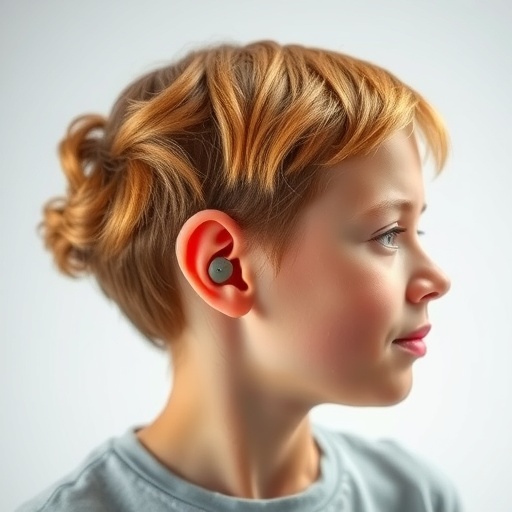In a world where technology increasingly intersects with the human experience, researchers are pursuing groundbreaking methods to enhance the auditory journey for cochlear implant users. The recent study spearheaded by Kopsch, Plontke, and Rahne has unveiled innovative acoustic simulations designed to mimic the sound perception of electric hearing. This meticulous investigation stands to unveil new horizons in how we understand and approach auditory prosthetics, potentially reshaping the landscapes of auditory rehabilitation.
Cochlear implants have revolutionized the treatment of profound hearing loss, enabling individuals to experience sound in a way that was previously unimaginable. However, the auditory experience provided by these devices can differ significantly from natural hearing. The study published in Scientific Reports seeks to bridge this gap by using acoustic simulations to approximate the user’s perceptual experience of hearing via cochlear implants. By leveraging advanced technological frameworks, the research team aimed to enhance the auditory experience, enabling a deeper understanding of these devices’ perceptual nuances.
For many cochlear implant users, the perception of sound is often described as mechanical or electronic, which can be attributed to how electrical stimulation interacts with the auditory system. This research delves into the complex acoustic properties of sound when transmitted through the cochlear implant, analyzing how these properties can be optimized through simulation. The goal is not only to improve the auditory experience but also to tailor sound modulation in a way that aligns more closely with the natural auditory experience of hearing.
Acoustic simulation techniques allow for the construction of an auditory environment that reflects the unique experiences of cochlear implant users. By simulating the nuanced sounds that a person with natural hearing would experience, researchers provide insights into how these devices can be enhanced. The use of sophisticated algorithms and sound modeling techniques facilitates a more profound understanding of sound perception, offering a glimpse into the acoustic reality that these individuals face daily.
The implications of this research extend beyond technical advancements; they encompass a richer appreciation for the auditory experiences of those reliant on cochlear implants. By simulating acoustic environments, the authors aim to create a more inclusive paradigm for auditory rehabilitation. Tailoring sound experiences could lead to a significant improvement in the quality of life for individuals with hearing impairments, allowing them to engage more fully in conversations, music, and ambient sounds in their environment.
Encouragingly, the research highlights the importance of interdisciplinary collaboration between audiologists, acoustic engineers, and psychologists. Such collaborations are invaluable in developing a more holistic approach to auditory rehabilitation. Understanding how sound influences emotional well-being, communication efficacy, and social integration is crucial in designing better auditory devices and rehabilitation programs that truly serve the needs of users.
Additionally, the profound use of technology in this study reflects ongoing advancements in artificial intelligence and sound technology. Various sound simulation models can replicate complex auditory stimuli that individuals with normal hearing perceive effortlessly. This opens new avenues for research, encouraging further exploration into the realms of binaural hearing and spatial sound perception, thereby enhancing the efficacy of cochlear implants.
In a practical sense, the findings of this research could lead to improved programming for cochlear implant processors, making them more adaptable to different acoustic environments. As the team delves deeper into the intricacies of sound modulation, the potential for personalized sound experiences becomes increasingly feasible. This personalized approach may allow audiologists to provide more customized solutions for their patients, catering to individual preferences and environmental challenges.
Moreover, the advancement of sound simulation technology could contribute significantly to education and training programs for cochlear implant users. By providing realistic auditory simulations, prospective users can have a better understanding and preparedness for the auditory experiences they will encounter post-implantation. This proactive approach can alleviate anxiety and set realistic expectations for individuals embarking on their journey toward enhanced hearing.
As research progresses, it is vital to consider the broader implications of these findings on society. Audiovisual experiences profoundly shape our interactions and daily lives. Enhancing the auditory experience for cochlear implant users is not merely an improvement in technology; it symbolizes an overarching commitment to inclusivity and accessibility. The potential for enriched communication and social interaction is invaluable, reinforcing the significance of this research.
The study by Kopsch and colleagues is not just a solitary effort; it marks a pivotal contribution to a growing body of literature dedicated to improving the experiences of those with hearing impairments. As we grasp the technological intricacies involved and the human experiences entwined within them, we advance toward a world where the auditory landscape is accessible to all, irrespective of hearing abilities. The research encourages proactive discussions around auditory health and the consideration of diverse auditory experiences in technological design.
In conclusion, this study stands as a testament to the synergy between science and technology in addressing real-world challenges faced by individuals with hearing impairments. The innovative use of acoustic simulations represents a groundbreaking leap in our understanding of electrical hearing, promising to ignite further research and inspire future advancements. The continually evolving landscape of auditory technology shines a light on the experiences of cochlear implant users, paving the way for a more inclusive auditory future.
Subject of Research: Acoustic simulation of cochlear implant sound to approximate perceptual experience of electric hearing.
Article Title: Acoustic simulation of cochlear implant sound to approximate the perceptual experience of electric hearing.
Article References:
Kopsch, A.C., Plontke, S.K. & Rahne, T. Acoustic simulation of cochlear implant sound to approximate the perceptual experience of electric hearing.
Sci Rep 15, 38997 (2025). https://doi.org/10.1038/s41598-025-25711-z
Image Credits: AI Generated
DOI: https://doi.org/10.1038/s41598-025-25711-z
Keywords: Cochlear Implants, Acoustic Simulation, Electric Hearing, Auditory Rehabilitation, Sound Perception.




